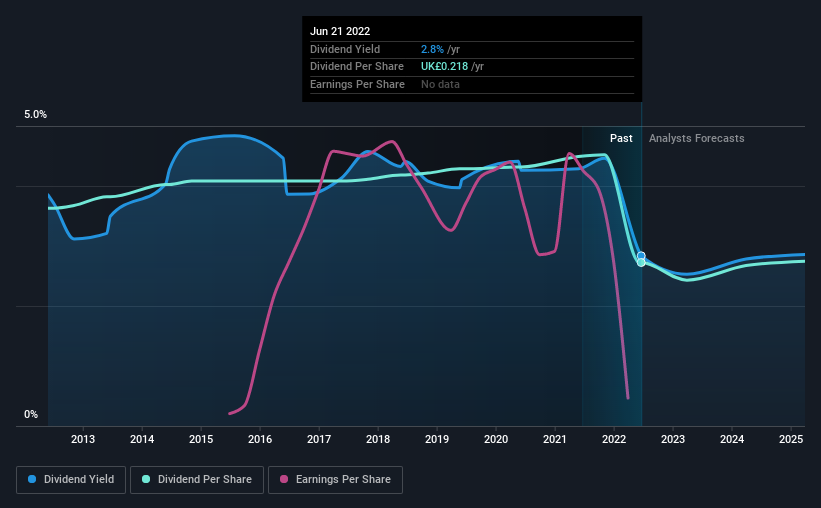Tate & Lyle (LON:TATE) Has Announced That Its Dividend Will Be Reduced To UK£0.13
Tate & Lyle plc (LON:TATE) is reducing its dividend to UK£0.13 on the 5th of August. The yield is still above the industry average at 17%.
View our latest analysis for Tate & Lyle
Tate & Lyle Is Paying Out More Than It Is Earning
Impressive dividend yields are good, but this doesn't matter much if the payments can't be sustained. Prior to this announcement, the dividend made up 334% of earnings, and the company was generating negative free cash flows. Paying out such a large dividend compared to earnings while also not generating free cash flows is a major warning sign for the sustainability of the dividend as these levels are certainly a bit high.
Over the next year, EPS is forecast to grow rapidly. Assuming the dividend continues along recent trends, we could see the payout ratio reach 350%, which is on the unsustainable side.
Dividend Volatility
Although the company has a long dividend history, it has been cut at least once in the last 10 years. Since 2012, the first annual payment was UK£0.29, compared to the most recent full-year payment of UK£0.22. The dividend has shrunk at around 2.8% a year during that period. Declining dividends isn't generally what we look for as they can indicate that the company is running into some challenges.
The Dividend Has Limited Growth Potential
With a relatively unstable dividend, it's even more important to evaluate if earnings per share is growing, which could point to a growing dividend in the future. Over the past five years, it looks as though Tate & Lyle's EPS has declined at around 37% a year. Such rapid declines definitely have the potential to constrain dividend payments if the trend continues into the future. However, the next year is actually looking up, with earnings set to rise. We would just wait until it becomes a pattern before getting too excited.
We're Not Big Fans Of Tate & Lyle's Dividend
To sum up, we don't like when dividends are cut, but in this case the dividend may have been too high to begin with. The company's earnings aren't high enough to be making such big distributions, and it isn't backed up by strong growth or consistency either. The dividend doesn't inspire confidence that it will provide solid income in the future.
It's important to note that companies having a consistent dividend policy will generate greater investor confidence than those having an erratic one. At the same time, there are other factors our readers should be conscious of before pouring capital into a stock. Case in point: We've spotted 3 warning signs for Tate & Lyle (of which 1 is a bit concerning!) you should know about. If you are a dividend investor, you might also want to look at our curated list of high yield dividend stocks.
Have feedback on this article? Concerned about the content? Get in touch with us directly. Alternatively, email editorial-team (at) simplywallst.com.
This article by Simply Wall St is general in nature. We provide commentary based on historical data and analyst forecasts only using an unbiased methodology and our articles are not intended to be financial advice. It does not constitute a recommendation to buy or sell any stock, and does not take account of your objectives, or your financial situation. We aim to bring you long-term focused analysis driven by fundamental data. Note that our analysis may not factor in the latest price-sensitive company announcements or qualitative material. Simply Wall St has no position in any stocks mentioned.

 Yahoo Finance
Yahoo Finance 
